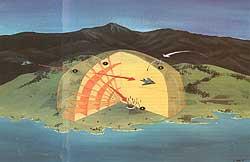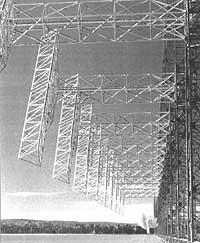F-117: Plane invisible
1991/05/01 Uzkudun, Maddi Iturria: Elhuyar aldizkaria
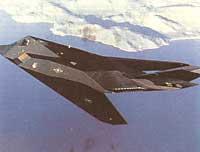
Throughout the spring of 1989 dozens of people saw the sky of California crossing objects of strange appearance. All the witnesses made the same description: they gave them the shape of triangles, the head in arrow, lived three yellow lights directed toward the sun and, at the previous end, an intermittent red light.
Although the UFOs (Unknown Steering Object, known in Spanish by the acronym UFO) appeared more and more, the Pentagon was mute, without explanation.
Until April 1990, the EGB knot was unsolved until US Air Force presented its unpredictable Stealth Fighter, Lockheed F-117 A. Earlier, in November 1988, US Air Force first announced this plane, which until then was secret, but no one saw it and no one thought California's OVI could be F-117.
His history and development, as invisible and confidential as the plane itself, began in 1973. At that time the U.S. Department of Defense used a small four-seater charcoal to measure the radar signal emitted by planes built with non-metallic materials: Windecker Eagle I, manufactured only with dielectric composites (which do not drive the electric current), specifically with fiberglass. The results of the trials were optimistic and that prompted the progress of the investigations.
At the end of 1973 a black program was launched, which consists of the use of hidden funds and which little public knows. The objective of the program was to make a plane specially prepared for inspection and attack missions, which could not have been detected for enemy radars. Several large aviators presented their project. Finally, in 1976, Lockheed acquired the contract: 30 million dollars to build two prototypes. They were baptized as EST ( Experimental Stealth Tactical ). Stealth (confidant) first appeared in the history of aviation.

The prototype made its first flight in November 1977. To keep it secret, it was transported in trucks to the military base of Nellis, in the state of Nevada. The base of Nellis is impressive, superior to all Euskadi. After several sessions, the EST prototype showed that it served to escape enemy radars. In 1978, always under the secret, Lockheed and the U.S. Department of Defense signed a contract for the serial manufacture of a EST based aircraft. Two were the functions assigned to the plane in the contract itself: the tactical inspection of well-equipped areas of anti-aircraft defense and the attack on preferential targets well protected such as missile batteries, radar antennas, communication bases, bridges, etc. Thus was born the F-117.
Since 1981 he made his first flight of premiere in the F-117 and since October 1983 has been used by a special squadron called 4450th Tactical Group. Use it yes, but not in any way. They did not leave day for anyone to see. For that reason, during the day only the Corsair II aircraft were used. They were introduced with a series of changes and adaptations that configured the features of the F-117. These took off only at night and acted on the polygon of Nellis without crossing its limits.
It is not surprising, therefore, that no one knows that this plane existed (at the public and media level). However, an accident occurred on 11 July 1986 alerted curious journalists and experts in aeronautics. That day he left his base at one and a quarter in the morning for a regular night training flight of the F-117. At 6,000 meters of altitude in the sky of California, it collapsed sharply down and broke out against a hill. The pilot could not pull himself and fell by the plane.
They immediately closed the entire area of the accident. As in sci-fi films, US Air Force inspectors banned local authorities and witnesses from reporting on what happened and what they saw. In the hours after the accident several square kilometers of surface were closed, traffic was cut and flights on the place of accident were banned. The journalists attending were unable to satisfy their curiosity: a chain of well-armed soldiers made the efforts to surround themselves useless. That military responsibility in the damage gave much to think of the experts. It was, without a doubt, an ultrasound plane. But what?
It was not the only accident. Earlier, in June 1982, an F-117 exploded in the same Nellis polygon, but was not known to the military. Later, in October 1987, another F-117 exploded against the land in the area of Nellis, with the death of the pilot.
How is an invisible plane?
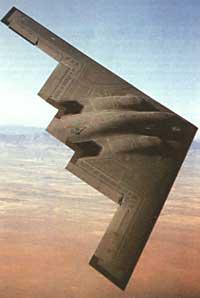
It is a reactor and pleasant. It has angular shapes and in that sense is totally revolutionary. The profile of the pioneering spy planes U-2 and SR-71 was much more classic. Because many smooth surfaces are formed by angles, without any being able to enjoy or round, their resistance is quite high.
The base is aluminum, but the composite material is abundant, especially the stratified Fibaloy. This composite is very good RAM (Material Radar Absor>, Material Radar-Absorbent) and has been used in most of the chassis of the structure of the apparatus, reinforcements, crossings and panels covering wings and fuselage. In addition, another composite is used as a reinforcement of the Fibaloy material, called Filcoat, in resin-coated carbon fibre bands. Somehow, if the Fibaloy were concrete, the Filcoat would fulfill the function of iron bars in reinforced concrete.
On the other hand, to limit the infrared emission of the plane, all the parts that are heated, as the panels next to the reactors or the edges of attack and the two leads of the wings, are covered by a special carbon fiber. The leads, for example, are aluminum, but have a thick layer of RAM on top.
The design of the F-117 itself contributes to reducing the equivalent radar surface of the aircraft. The entire upper part of the structure is formed by a set of earrings that join forming angles greater than 30 degrees. The aldescos behave like a mirror: the radar waves that collide against them propagate in all directions without returning to the source of emission. Despite the fact that one of these slopes would return the radar wave to the proper direction, the radio would hardly receive that echo, since, according to the designers, 98% of the emission energy would be absorbed by Fibaloy's coverage of the plane. In addition, the interior and exterior metallic elements of the plane are covered with a painting formed by metallic fractions and, in addition, all the slits (like crystals and fuselage, doors, etc.) They are hidden by a cover in the form of saw teeth to scatter radar waves in all directions.
Reactors Reactors
The reactors are fitted in a polymer cap. The case is filled with small empty pyramids that cushion the echo of radar waves and reduce the noise levels of the engine. The air accesses of the reactors are located on both sides of the fuselage, on the wings and parallel to the edge of attack of the wings, to attenuate the radar signal. The reactors are equipped with a protective grid of composites. The stops of the grid are very small, with an approximate surface of 1 cm 2. In addition, the grilles are equipped with an antifreeze electrical system.
To reduce the infrared emissions of high-temperature gas that expel the reactors, the outputs of the nozzles contain diffuser vertical lamas. These slats cover the entire length of the fuselage exhaust edge. In addition, there are additional air accesses on the housing of each reactor. These absorb cold air and after passing the air through an independent circuit it is mixed with the hot gas that leaves the hoppers. This system provides a two remove the across of gas exchanges at the flow difference, and driven the exit temperature of the gas. Thus, it avoids attracting the missiles guided by infrared emissions. However, both diffuser slats and auxiliary air accesses limit the performance of reactors.
Other features Other features
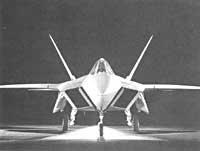
This curious and angular geometry of the plane is not very aerodynamic, nor the most suitable to ensure the stability of the plane. Therefore, it uses a very complex stabilization system based on electric flight commands of quadruple circuit by pressure sensors, called FBW ( Fly by Wire ).
The cockpit window is treated by a multisports procedure to attenuate the electromagnetic radiation produced by the pilot's equipment (microphones, helmets, visors, etc. ). For low-height and unvisibility flights, the pilot is equipped with a laser illuminator, an infrared camera to detect obstacles and a TV camera, all connected to the viewfinder in front of the eyes. In the basement or cargo can carry almost a ton of pump. Of all kinds: laser guided bombs; optical guided ground air missiles; wave guided anti-radar missiles emitted by radar antennas themselves; airborne air missiles self-carried by infrared rays; etc.
Thanks to its special design and the absorbent materials used, the equivalent radar surface of the F-117 ranges from 0.01 to 0.001 m 2. A seagull would leave more footprint on the radar screen! In low-rise flight you can easily cross radar networks. Its echo would be confused on the radar screen with the noise emitted by the sun itself.
MAIN FEATURES OF F-117 STEALTH
- Width between the outer edges of the wings: 13.23 m from 13.23 m
- Length: 19.85 m from 19.85 m
- Height: Height: 3.81 m from 3.81 m
- Surface of wings: 239 m 2
- Empty weight: Empty weight: 9.072 kg kg
- Engines: two turbo-reactors without post-convex, General Electric F-404, with an approximate unit thrust of 5.6 tons.
- Speed of approach to landing: 278 km/h
- Speed on land: 194 km/h
- Scope or autonomy: 640 km 640 km
- Cruising speed: 0.8-0.9 Mach
- Maximum height: 10.970 m m
- Price: 106 million dollars (106.000 million pesetas or 53 million pounds)
On 21 April 1990, US Air Force presented the F-117 to journalists. The Department of Defense informed that it was necessary to report the F-117, since henceforth the use of the plane could not be reduced to night flights and over the desert. However, before its official presentation, the F-117 had taken the baptism of fire. It was in Panama; on the night of December 19-20, 1989, the F-117 bombed the soldiers of General Noriega before the US Army paratroopers fell. But especially in recent days it has become an invisible plane for the general public, in the unfortunate Persian Gulf war. And while the war had not yet begun and the journalists sent to the Gulf had not much to do, when they began to vindicate the excellencies of the U.S. war machine (I am afraid I am also doing something like this article) we learned that in Saudi Arabia there were about 20 F-117. Later, 10 days after the war, we learned that the F-117 Stealth were the ones who officially launched the war, when on January 17 they launched the first war bombs against a communications tower in Baghdad. And already in the midst of the whirlwind of the war, we learned that a F-117 Stealth had launched on February 13 the two bombs that destroyed the Al-Amiriah shelter in Baghdad and killed hundreds of civilians. Science and technology are not neutral. Seeing the back of the aseptic news about technology is a function of the reader's common sense, making that back part of what the writer is. |
As we have seen, billions of dollars have been spent and a work of years has been needed to obtain results like the F-117. Apparently total result, unsurpassed by radiodetection. However, the new generation of radars has already begun to be announced, which would also detect the undetectable in undetectable aircraft: the super-radar, a French system called RIAS. The crazy career of military technology has begun to climb another step in a spiral staircase that leads to no place. |

Gai honi buruzko eduki gehiago
Elhuyarrek garatutako teknologia



